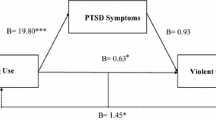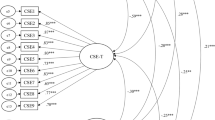Abstract
Introduction
Research within the field of traumatic stress has documented a strong link between posttraumatic stress disorder (PTSD) and adverse physical health outcomes, although the mechanisms contributing to this relationship are unclear.
Method
The current study examined substance use behaviors as one such mediator in a mixed civilian trauma population. Participants were 136 undergraduates exposed to a variety of civilian traumas. They completed measures assessing trauma exposure, substance use behaviors, and physical health outcomes.
Results
Moderate correlations were found between PTSD symptom severity, substance use, and adverse health outcomes. Mediational analyses indicated that substance use behaviors, especially alcohol and drug use, mediated the relationship between PTSD and health outcomes.
Similar content being viewed by others
References
American Psychiatric Association. (1994). Diagnostic and statistical manual of mental disorders (4th ed.). Washington, DC: American Psychiatric Association. Revised.
Baron, R. M., & Kenny, D. A. (1986). The moderator-mediator variable distinction in social psychology research: Conceptual, strategic, and statistical considerations. Journal of Personality and Social Psychology, 51, 1173–1182.
Beckham, J. C., Moore, S. D., Feldman, M. E., & Hertzberg, M. A. (1998). Health status, somatization, and severity of posttraumatic stress disorder in Vietnam combat veterans with posttraumatic stress disorder. The American Journal of Psychiatry, 155, 1565–1569.
Blake, D. D., Weathers, F. W., Nagy, L. M., Kaloupek, D. G., Gusman, F. D., Charney, D. S., et al. (1995). The development of a clinician-administered PTSD scale. Journal of Traumatic Stress, 8, 75–90.
Boscarino, J. A. (1997). Diseases among men 20 years after exposure to severe stress: Implications for clinical research and medical care. Psychosomatic Medicine, 59, 605–614.
Brener, N. D., McMahon, P. M., Warren, C. W., & Douglas, K. A. (1999). Forced sexual intercourse and associated health-risk behaviors among female college students in the United States. Journal of Consulting and Clinical Psychology, 67, 252–259.
Chilcoat, H. D., & Breslau, N. (1998). Posttraumatic stress disorder and drug disorders: Testing causal pathways. Archives of General Psychiatry, 55, 913–917.
Ciechanowski, P. S., Walker, E. A., Russo, J. E., Newman, E., & Katon, W. J. (2004). Adult health status of women HMO members with posttraumatic stress disorder symptoms. General Hospital Psychiatry, 26, 261–268.
Cohen, S., & Williamson, G. M. (1991). Stress and infectious disease in humans. Psychological Bulletin, 109, 5–24.
Cook, J. M., Elhai, J. D., Cassidy, E. L., Ruzek, J. I., Ram, G. D., & Sheikh, J. I. (2005). Assessment of trauma exposure and post-traumatic stress in long-term care veterans: Preliminary data on psychometrics and post-traumatic stress disorder prevalence. Military Medicine, 170, 862–866.
Engel, C. C. (2004). Somatization and multiple idiopathic physical symptoms: Relationship to traumatic events and posttraumatic stress disorder. In P. P. Schnurr & B. L. Green (Eds.), Trauma and health: Physical health consequences of exposure to extreme stress (pp. 191–215). Washington, DC: American Psychological Association.
Fagerstrom, K., & Schneider, N. G. (1989). Measuring nicotine dependence: A review of the Fagerstrom Tolerance Questionnaire. Journal of Behavioral Medicine, 12, 159–182.
Friedman, M. J., & McEwen, B. S. (2004). Posttraumatic stress disorder, allostatic load, and medical illness. In P. P. Schnurr & B. L. Green (Eds.), Trauma and health: Physical health consequences of exposure to extreme stress (pp. 157–188). Washington, DC: American Psychological Association.
Friedman, M. J., & Schnurr, P. P. (1995). The relationship between trauma, post-traumatic stress disorder, and physical health. In M. J. Friedman & A. Y. Deutch (Eds.), Neurobiological and clinical consequences of stress: From normal adaptation to post-traumatic stress disorder (pp. 507–524). Philadelphia, PA: Lippincott-Raven.
Gavin, D. R., Ross, H. E., & Skinner, H. A. (1989). Diagnostic validity of the Drug Abuse Screening Test in the assessment of DSM-III drug disorders. British Journal of Addiction, 84, 301–307.
Herman, J. (1997). Trauma and recovery: The aftermath of violence-from domestic abuse to political terror. New York, NY: Basic Books.
Kramer, M. C., Kiernan, M., Essex, M., & Kupfre, D. (2008). How and why criteria defining moderators and mediators differ between the Baron and Kenny and MacArthur approaches. Health Psychology, 27, S101–S108.
Lang, A. J., Laffaye, C., Satz, L. E., Dresselhaus, T. R., & Stein, M. B. (2003). Sensitivity and specificity of the PTSD checklist in detecting PTSD in female veterans in primary care. Journal of Traumatic Stress, 16, 257–264.
Marshall, G. N. (2004). Posttraumatic stress disorder checklist: Factor structure and English–Spanish measurement invariance. Journal of Traumatic Stress, 17, 223–230.
McDevitt-Murphy, M. E., Weathers, F. W., Flood, A. M., Eakin, D., & Benson, T. (2007). The utility of the PAI and the MMPI-2 for discriminating PTSD, depression, and social phobia in trauma-exposed college students. Assessment, 14, 181–196.
McFarlane, A. C., Atchison, M., Rafalowicz, E., & Papay, P. (1994). Physical symptoms in post-traumatic stress disorder. Journal of Psychosomatic Research, 38, 715–726.
McHorney, C. A., Ware, J. E., & Lu, F. J. R. (1994). The MOS 36-item Short-Form Health Survey (SF-36): III. Tests of data quality, scaling assumptions, and reliability across diverse patient groups. Medical Care, 32, 40–66.
McHorney, C. A., Ware, J. E., & Raczek, A. E. (1993). The MOS 36-item Short-Form Health Survey (SF-36): II. Psychometric and clinical tests of validity in measuring physical and mental health constructs. Medical Care, 31, 247–263.
Murphy, S. A., Lohan, J., Braun, T., Johnson, L. C., Cain, K. C., & Beaton, R. D. (1999). Parents’ health, health care utilization, and health behaviors following the violent deaths of their 12- to 28-year-old children: A prospective longitudinal analysis. Death Studies, 23, 589–616.
Neighbors, C., Larimer, M. E., Geisner, I. M., & Knee, C. R. (2004). Feeling controlled and drinking motives among college students: Contingent self-esteem as a mediator. Self and Identity, 3, 207–224.
Neighbors, C., Lee, C. M., Lewis, M. A., Fossos, N., & Larimer, M. E. (2007). Are social norms the best predictor of outcomes among heavy-drinking college students? Journal of Studies on Alcohol and Drugs, 68, 556–565.
Newman, M. G., Clayton, L., Zuellig, A., Cashman, L., Arnow, B., Dea, R., et al. (2000). The relationship of childhood sexual abuse and depression with somatic symptoms and medical utilization. Psychological Medicine, 30, 1063–1077.
Palmieri, P. A., Weathers, F. W., Difede, J., & King, D. W. (2007). Confirmatory factor analysis of the PTSD Checklist and the Clinician-Administered PTSD scale in disaster workers exposed to the World Trade Center ground zero. Journal of Abnormal Psychology, 116, 329–341.
Potts, M. K. (1994). Long-term effects of trauma: Post-traumatic stress among civilian internees of the Japanese during World War II. Journal of Clinical Psychology, 50, 681–697.
Rheingold, A. A., Acierno, R., & Resnick, H. (2004). Trauma, PTSD, and health risk behaviors. In P. P. Schnurr & B. L. Green (Eds.), Physical health consequences of exposure to extreme stress. Washington, DC: American Psychological Association.
Rodgers, C. S., Norman, S. B., Thorp, S. R., Lang, A. J., & Lebeck, M. M. (2005). Trauma exposure, posttraumatic stress disorder and health behaviors: Impact on special populations. In T. A. Corales (Ed.), Focus on posttraumatic stress disorder research (pp. 203–224). Hauppauge, NY: Nova Science Publishers.
Rudy, E. B., & Gray, V. R. (1986). Handbook of health assessment (2nd ed.). Norwalk, CT: Appleton-Century-Crofts.
Ruehlman, L. S., Lanyon, R. I., & Karoly, P. (1998). Multidimensional health profile professional manual. Odessa, FL: Psychological Assessment Resources, Inc.
Ruggiero, K. J., Del Ben, K., Scotti, J. R., & Rabalais, A. E. (2003). Psychometric properties of the PTSD checklist-civilian version. Journal of Traumatic Stress, 16, 495–502.
Schnurr, P. P. (1996). Trauma, PTSD, and physical health. PTSD Research Quarterly, 7, 1–8.
Schnurr, P. P., Friedman, M. J., Sengupta, A., Jankowski, M. K., & Holmes, T. (2000). PTSD and utilization of medical treatment services among male Vietnam veterans. Journal of Nervous and Mental Disease, 188, 496–504.
Schnurr, P. P., & Green, B. L. (2004). Understanding relationships among trauma, post-traumatic stress disorder, and health outcomes. Advances in Mind-Body Medicine, 20, 18–29.
Schnurr, P. P., & Spiro, A. (1999). Combat exposure, posttraumatic stress disorder symptoms, and health behaviors as predictors of self-reported physical health in older veterans. The Journal of Nervous and Mental Disease, 187, 353–359.
Sher, C. D., McCreary, D. R., Asmudson, G. J. G., & Resick, P. A. (2008). The structure of post-traumatic stress disorder symptoms in three female trauma samples: A comparison of interview and self-report measures. Journal of Anxiety Disorders, 22, 1137–1145.
Skinner, H. A. (1982). The drug abuse screening test. Addictive Behaviors, 7, 363–371.
Sobel, M. E. (1982). Asymptotic confidence intervals for indirect effects in structural equation models. In S. Leinhart (Ed.), Sociological methodology 1982 (pp. 290–312). San Francisco: Jossey-Bass.
Southwick, S. M., Bremner, D., Krystal, J. H., & Charney, D. S. (1994). Psychobiologic research in post-traumatic stress disorder. Psychiatric Clinics of North America, 17, 251–264.
Stein, M., & Miller, A. H. (1993). Stress, the immune system, and health and illness. In L. Goldberger & S. Breznitz (Eds.), Handbook of stress: Theoretical and clinical aspects (pp. 127–141). New York, NY: The Free Press.
Tate, J. C., & Schmitz, J. M. (1993). A proposed revision of the Fagerstrom tolerance questionnaire. Addictive Behaviors, 18, 135–143.
Uba, L., & Chung, R. C. (1991). The relationship between trauma and financial and physical well-being among Cambodians in the United States. Journal of General Psychology, 118, 215–226.
Ullman, S. E., & Siegel, J. M. (1996). Traumatic events and physical health in a community sample. Journal of Traumatic Stress, 9, 703–719.
Wagner, A. W., Wolfe, J., Rotnitsky, A., Proctor, S. P., & Erickson, D. J. (2000). An investigation of the impact of posttraumatic stress disorder on physical health. Journal of Traumatic Stress, 13, 41–55.
Ware, J. E., & Sherbourne, C. D. (1992). The MOS 36-item Short-Form health survey (SF-36): Conceptual framework and item selection. Medical Care, 30, 473–483.
Weathers, F. W., Litz, B. T., Herman, D. S., Huska, J. A., & Keane, T. M. (1993). The PTSD checklist: Reliability, validity, and diagnostic utility. Paper presented at the annual meeting of the international society for traumatic stress studies, San Antonio, CA.
White, H. R., & Labouvie, E. W. (1989). Towards the assessment of adolescent problem drinking. Journal of Studies on Alcohol, 50, 30–37.
Yehuda, R., Boisoneau, D., Lowy, M. T., & Giller, E. L. (1995). Dose-response changes in plasma cortisol and lymphocyte glucocorticoid receptors following dexamethasone administration in combat veterans with and without posttraumatic stress disorder. Archives of General Psychiatry, 52, 583–593.
Zatzick, D. F., Marmar, C. R., Weiss, D. S., & Browner, W. S. (1997). Posttraumatic stress disorder and functioning and quality of life outcomes in a nationally representative sample of male Vietnam veterans. The American Journal of Psychiatry, 154, 1690–1695.
Author information
Authors and Affiliations
Corresponding author
Rights and permissions
About this article
Cite this article
Flood, A.M., McDevitt-Murphy, M.E., Weathers, F.W. et al. Substance use behaviors as a mediator between posttraumatic stress disorder and physical health in trauma-exposed college students. J Behav Med 32, 234–243 (2009). https://doi.org/10.1007/s10865-008-9195-y
Received:
Accepted:
Published:
Issue Date:
DOI: https://doi.org/10.1007/s10865-008-9195-y




